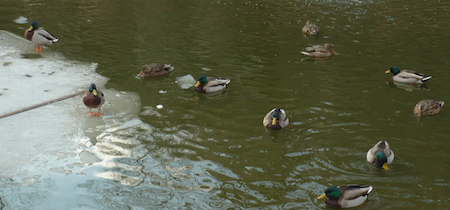I first conceived this project – visiting and documenting every park in New York City – a couple of years ago, while I was working at Columbia University 
Part of the inspiration for the whole blog project, in fact, came specifically from the dramatic geography of Morningside's steep rocky slopes cut by grand stone staircases.

Yet in all this time, I hadn't actually covered Morningside Park here on the blog. So, for my documentary visit, I returned just a few days after the big snowstorm of February 2013 to walk the park's full length. Subsequent warm air and rain had trimmed the snow cover, but an icy white landscape remained.

Winter doesn't scare away the wildlife around here.



Skinny, but 13 blocks long, Morningside Park was conceived just after the Civil War, though construction didn't begin until the 1880s.  Architect Jacob Wrey Mould and legendary park designers Frederick Law Olmstead and Calvert Vaux (of Central Park and Prospect Park fame) all had hands in the design. According to the Parks Department's website, "Retained as a consultant, Vaux saw the work to completion in 1895, the year he drowned in Gravesend Bay. Parks Superintendent Samuel Parsons Jr. wrote of Vaux's work, '…perhaps Morningside Park was the most consummate piece of art that he had ever created.'"
Architect Jacob Wrey Mould and legendary park designers Frederick Law Olmstead and Calvert Vaux (of Central Park and Prospect Park fame) all had hands in the design. According to the Parks Department's website, "Retained as a consultant, Vaux saw the work to completion in 1895, the year he drowned in Gravesend Bay. Parks Superintendent Samuel Parsons Jr. wrote of Vaux's work, '…perhaps Morningside Park was the most consummate piece of art that he had ever created.'"
Artful or otherwise, a walk along the cliff provides some remarkable natural sights.

Needless to say, Native American tribes haven't resided here for a very long time. You won't run into any Dutch farmers in the area either, but somebody left some hay bales next to a couple of the park's fattest old trees.

In one of those New York City juxtapositions I always enjoy coming across, behind another big tree you can see the bright colors of a schoolyard mural.

The really well-known piece of art in Morningside Park is the eight-foot-tall bronze Bear and Faun, or the Alfred Lincoln Seligman Fountain,
In wintertime it's quiet and still, but hardly less prominent as it guards the base of one of the park's great staircases.
The sculpture actually depicts a bear, on top of a crag, apparently stalking a fawn who's hiding in the mouth of a little cave below. But to me, the shape of the whole sculpture has always suggested a crouching female figure.

Of course, as happens so often in cities, wealthier people claim the higher ground while lower-income folks live down below. In few places is this more obvious than the Morningside Park area, where the top of the ridge houses the grand buildings of Columbia University and many fancy apartment buildings, while down below, to the east of the park, resides the working class. Nonetheless, one of the best qualities of city parks like Morningside is that everyone has equal access, whether you skitter down from the west or walk in from the east.
No comments:
Post a Comment